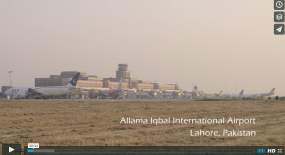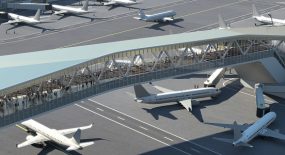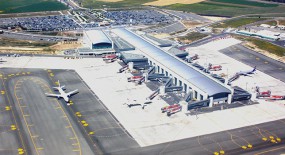
Several years ago, LED technology transformed airfield ground lighting. Its adoption has since been rapid and unstoppable as airports reap the rewards of substantially lower energy costs, ultra-long lamp life, high-quality output and much faster response times compared to the conventional halogen lighting. Build a safer, lower cost airfield. Today, we stand on the threshold of a further transformation as advanced control systems build on the capabilities of LED lighting and other technologies to create the intelligent airfield.
The intelligent airfield will transform airport operations
The intelligent airfield is more than just switching lights on and off. It’s about controlling the lighting units individually, monitoring them automatically and maintaining them without disrupting airport operations. And it’s about greatly improving airfield safety by providing Air Traffic Control (ATC) with much better situational awareness and control.
In an intelligent airfield, integrating the control of airfield lighting with airfield surveillance and aircraft tracking systems achieves optimum aircraft routing to and from gates to solve airport congestion.
We explore six reasons for evolving to an intelligent airfield and how to achieve the benefits.
- Reduce airfield energy consumption
Simply converting airfield ground lighting from conventional halogen technology to LED lighting saves around 75% energy because each fitting uses less power. These savings are further boosted by installing an Integrated Lighting Control and Monitoring System (ILCMS) operating in a low current environment to reduce power losses in cabling. Installing an ADB SAFEGATE SafeLED IQ 2A low-current solution greatly increases energy efficiency and reduces energy consumption by 33% compared to conventional LED installations. In addition, the ILCMS individually controls each lighting fixture, saving further energy by illuminating only those lights needed to guide each aircraft along its taxi route as part of a Follow The Greens implementation. - Cut airfield capital expenditure
A modern ILCMS significantly reduces the time and cost of installing airfield lighting systems. The traditional design, with constant current regulator (CCR) and cable, can be complicated and expensive to install and requires a lot of cable, leading to higher power consumption. Significant capital cost reductions are achieved by the ADB SAFEGATE ILCMS and SafeLED IQ 2A system which enables several separate circuits to be consolidated into one without any reduction in control flexibility or redundancy. Circuit consolidation enables fewer circuits, which means there is less cable and fewer CCRs to install and commission. Lower power consumption also means substantial cost savings can be made in the supporting substation equipment, such as the backup generator. - Achieve safer airfield operations
An ILCMS improves situational awareness for ATC and brings significant safety benefits. A ‘Follow The Greens’ system can automatically illuminate only the taxiway centreline lights required to guide an aircraft to its gate. In its most advanced form, ‘Follow The Greens’ actively illuminates only a short strip of lighting ahead of each aircraft as it taxis, switching off segments not needed. Such intelligent taxiway routing eliminates pilot confusion caused by all taxiways being lit, and reduces route deviations and results in safer operations. Safe guidance could potentially even be maintained should communications between ATC and aircraft be interrupted, or when poor visibility would otherwise hamper operations. Integrated airfield systems can also automatically alert ATC of any runway incursions, route deviations, area infringements or other safety violations. - Handle more traffic with existing infrastructure
Integrating ILCMS with Advanced Surface Movement Guidance and Control System (A-SMGCS) creates more efficient ground traffic flows that substantially improves efficiency. More efficient aircraft movements reduce taxiing time, especially at large hub airports with a complex layout of interlocking taxiways or with capacity restraints.The clear user interface of the ADB SAFEGATE SafeControl system also ensures that implementing intelligent routing does not add to the workload of air traffic controllers or system managers, freeing up resources to handle more traffic.The intelligent airfield can immediately and automatically identify when maintenance of airfield lighting is needed. This allows scheduled maintenance to improve airfield availability and help avoid unnecessary deployment of maintenance crews that could disrupt airfield operations. - Increase airport sustainability
The energy savings achieved by intelligently controlled LED lighting helps reduce an airport’s emissions. The annual CO2 savings realised at one airfield by using SafeLED IQ 2A are equivalent of taking 36 passenger vehicles off the road for a year when compared to a standard LED lighting solution, or removing 173 passenger vehicles when compared to a standard halogen system. Additional emissions savings are achieved by intelligent routing that reduces the time an aircraft spends taxiing and burning fuel, and through more effective scheduling of movements to avoid delays at the gates and while awaiting runway clearances. Remote monitoring of lighting also reduces the need for maintenance crew to drive regularly across the airfield for photometric measurements or other manual testing, reducing vehicle emissions. - Use maintenance resources more efficiently
Efficient maintenance improves airfield safety and operations. In a traditional lighting system, it isn’t possible to differentiate between a critical and non-critical lamp failure. Not knowing which lamps aren’t working requires time-consuming and costly maintenance and leads to delays, increased fuel consumption and higher carbon emissions. With an average life of around 50,000 hours, LED lighting inherently needs less maintenance. When combined with an ILCMS, lights can be centrally monitored. By knowing the exact status of every light, maintenance personnel can be directed to problems quickly, ensuring minimal downtime or disruption to operations and reducing total maintenance costs by 50% through targeted maintenance and reduced inspection workload.
The intelligent airfield – it’s easier than you might think
Intelligence does not have to be complex to implement. In the last 10 years, ILCMS has evolved substantially. The latest systems are easily integrated with an airport’s existing infrastructure with minimal disruption to airfield operations. This is a critical factor for the busiest airports that have few windows of opportunity free of aircraft movements to allow teams onto the airfield to install and maintain ground lighting.
By taking the opportunity to install an ILCMS during a planned shutdown or runway refurbishment, airports can start with a small installation covering the basic needs of light monitoring. This also lays the foundation for easy extension of the system’s capabilities to match growing demands and as and when an airport’s needs change.
Major hub airports will look to install ILCMS as a prerequisite for evolving to a full A-SMGCS with advanced ‘Follow The Greens’ capability. On the other hand, a medium-size airport may have bottlenecks that restrict capacity, while smaller airports may lack important capabilities such as stop bars or may want to add taxiways as infrastructure upgrades.
ADB SAFEGATE is a leading provider of intelligent solutions that deliver superior airport performance from approach to departure. We partner with airports and airlines to analyze their current structures and operations, and jointly identify and solve bottlenecks. Our consultative approach enables airports to improve efficiency, enhance safety and environmental sustainability, as well as reduce operational costs. Our portfolio includes solutions and services that harmonize airport performance, tackling every aspect of traffic handling and guidance, from approach, runway and taxiway lighting, to tower-based traffic control systems and intelligent gate and docking automation. ADB SAFEGATE has 900+ employees in more than 20 countries and serves some 2,500+ airports in more than 175 countries.















Leave a Comment